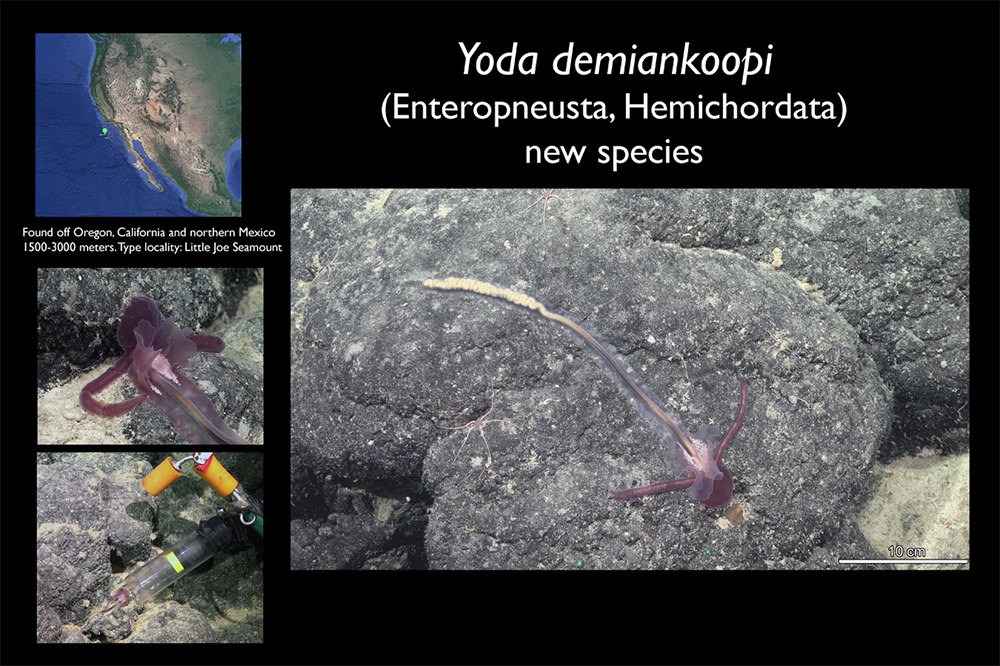Named after two other entities a new species is—and one of them is Yoda! An unusual deep-sea acorn worm within the genus Yoda—named so after that iconic Jedi Master—has made the “Top 10 New Marine Species” list by the World Register of Marine Species (WoRMS).
The list acknowledges incredible new species discovered or described in 2022, with an announcement on March 19, 2023, to coincide with Taxonomist Appreciation Day—a day that shines a light on the important work done by taxonomists in charge of classifying, naming, and describing existing biological organisms.
A team of marine scientists and taxonomists at Scripps Institution of Oceanography at UC San Diego officially described the new acorn worm species, Yoda demiankoopi, in a paper published July 5, 2022, in the journal Invertebrate Biology. The creature also made the cover of the journal’s September 2022 issue.
The deep-sea dweller was named in honor of Demian Koop, a developmental biologist and former postdoctoral scholar at Scripps who passed away unexpectedly in 2021. While at Scripps, Koop worked in the lab of marine biologists Nicholas and Linda Holland, now both emeritus professors.

Acorn worms live above or buried in the seafloor, where they feed on sediment or particles that settle on their bodies. They range in size from just 1 millimeter (0.1 centimeter) to over 2 meters (6.6 feet) long.
Yoda demiankoopi had been spotted previously, but had never been collected in a way that allowed for a detailed anatomical study. Then, in 2021, the Schmidt Ocean Institute’s remotely operated vehicle (ROV) SuBastian successfully collected several specimens at depths between 1,573 and 2,476 meters (5,161 and 8,123 feet) off the Pacific coast of northern Mexico. This collection enabled the Scripps research team—Nicholas Holland, Avery Hiley, and Greg Rouse—to analyze the specimens and formally describe the creature in a scientific paper.
“Having this bizarre creature named in the top 10 is a reflection of what’s still to be discovered in the deep sea,” said Rouse, an expert on marine worms and manager of the Benthic Invertebrate Collection at Scripps. “We were fortunate to have the Schmidt Ocean Institute and their very skilled pilots be able to collect such specimens that are very delicate in such good condition for the study that we were able to do.”
The genus Yoda was first described in 2012 and earned its name from the worms’ long lip-like structures that resemble the long ears of Yoda, the Star Wars character. The species Yoda demiankoopi is unusual in that it has both male and female reproductive organs, and only one set of reproductive organs functioning at a time. The animal will sometimes breed as a male and other times as a female, a process known as sequential hermaphrodism.
Acorn worms are some of the closest invertebrate relatives to humans. Hemichordates split off from the ancestors of vertebrates, including humans, 500 million years ago. Our evolutionary relationship to these worms is still strikingly evident in our genome and in the gill slits that we temporarily possess as embryos, said Rouse.
Scientific knowledge of marine species around the globe is furthered by “underwater libraries” of preserved specimens, known as collections. Scripps Oceanography is home to several world-renowned repositories of marine organisms and geological samples supporting scientific research, education, and governmental agencies and public policymakers. This includes the Benthic Invertebrate Collection, a research repository of more than 800,000 specimens from some of the most unexplored and extreme environments on Earth—including the deep sea; the Marine Vertebrate Collection, one of the world’s largest collections of deep-sea and pelagic fishes; and the Pelagic Invertebrate Collection, one of the world's preeminent collections of marine zooplankton. Scripps also houses one of the largest collections of marine geology samples in the United States in its Geological Collections, a trove of deep-ocean cores, rock samples, and marine microfossils.
The Scripps taxonomists who described Yoda demiankoopi said they hope that this unique acorn worm and other creatures highlighted in the WoRMS top 10 list may inspire people to learn more about the incredible marine life found worldwide—and efforts to protect the places these creatures call home.
In a playful nod to the Star Wars connection, the authors noted, “In the words of the Jedi Master: many new discoveries in the deep sea there are.”
About Scripps Oceanography
Scripps Institution of Oceanography at the University of California San Diego is one of the world’s most important centers for global earth science research and education. In its second century of discovery, Scripps scientists work to understand and protect the planet, and investigate our oceans, Earth, and atmosphere to find solutions to our greatest environmental challenges. Scripps offers unparalleled education and training for the next generation of scientific and environmental leaders through its undergraduate, master’s and doctoral programs. The institution also operates a fleet of four oceanographic research vessels, and is home to Birch Aquarium at Scripps, the public exploration center that welcomes 500,000 visitors each year.
About UC San Diego
At the University of California San Diego, we embrace a culture of exploration and experimentation. Established in 1960, UC San Diego has been shaped by exceptional scholars who aren’t afraid to look deeper, challenge expectations and redefine conventional wisdom. As one of the top 15 research universities in the world, we are driving innovation and change to advance society, propel economic growth and make our world a better place. Learn more at ucsd.edu.